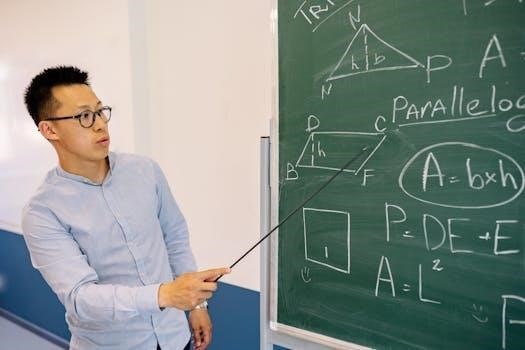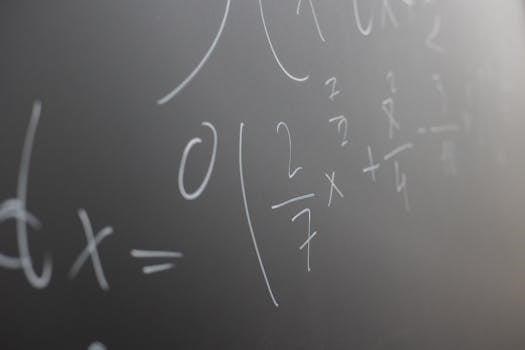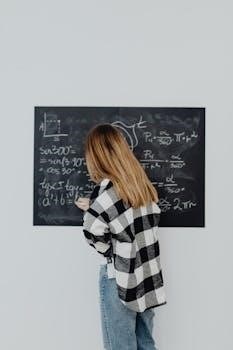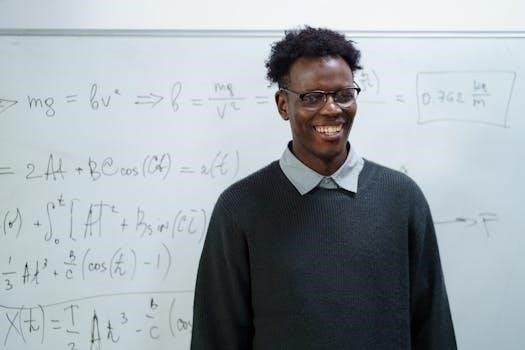Overview of Differential Equations and Linear Algebra 4th Edition
This fourth edition is designed for a sophomore-level course, integrating core concepts of both differential equations and linear algebra. It emphasizes understanding over rote learning, fostering a solid foundation in key areas. The text uses real world applications, blending algebraic and geometric approaches to mathematical modeling.
Core Concepts of the Textbook
The textbook delves into the fundamental theories of both differential equations and linear algebra, providing a balanced approach to concepts, visualization, and practical applications. It covers core topics in elementary differential equations, seamlessly integrating them with the concepts and methods of elementary linear algebra. This integration allows students to explore the interconnections between these two vital mathematical areas, enhancing their overall understanding. The text emphasizes a contemporary approach, focusing on mathematical modeling of real-world phenomena. The book is structured to facilitate a deep comprehension of abstract concepts, ensuring students grasp the underlying principles rather than just memorizing formulas. It encourages active problem-solving, allowing students to apply their knowledge to diverse situations. The material is presented in a clear, logical manner, without compromising on rigor. The fourth edition incorporates fresh computational and qualitative aspects, enriching the learning experience with new perspectives, figures, examples, and real-world problems.
Integration of Differential Equations and Linear Algebra
This textbook uniquely combines the study of differential equations with linear algebra, demonstrating how these two branches of mathematics are interconnected and mutually reinforcing. The integration is not merely a juxtaposition of topics; rather, it’s a deliberate weaving together of concepts and methods. This approach allows students to see how linear algebra provides tools and techniques that are crucial for solving differential equations, and conversely, how differential equations can be used to understand and model linear systems. By covering core topics in both subjects concurrently, the book fosters a deeper appreciation for the mathematical structure and its real-world applications. The text emphasizes the blend of algebraic and geometric approaches, ensuring a well-rounded understanding. The goal is to move beyond the traditional siloed approach to these subjects, encouraging students to think holistically and apply concepts from one area to the other, leading to enhanced problem-solving capabilities and a more complete mathematical foundation.

Key Features of the 4th Edition
The fourth edition offers a fresh perspective with computational and qualitative elements seen in examples and applications. It is known for real world applications and blends algebraic and geometric methods. It also contains the best problem sets.
Emphasis on Real-World Applications
This edition of “Differential Equations and Linear Algebra” strongly emphasizes the practical relevance of the material through numerous real-world applications. The authors skillfully integrate these applications to demonstrate how abstract mathematical concepts can be used to model and solve concrete problems in various fields. This approach ensures that students not only grasp the theoretical underpinnings but also understand the practical significance of the subject matter. The book begins and ends with discussions of how mathematical modeling can be used to explain real phenomena. This is supported by figures, examples and problems throughout the text. By showcasing these connections, the textbook motivates students to delve deeper into both differential equations and linear algebra, as they see the practical value of what they are learning. The use of real-world examples also helps to make abstract concepts more understandable and relatable. This allows students to see the direct link between the theory they are learning and the world around them. This approach is a central part of the textbook.

Abundance of Examples and Illustrations
The fourth edition of “Differential Equations and Linear Algebra” is characterized by its extensive use of examples and illustrations to clarify complex concepts. The book provides a wealth of examples that are carefully chosen to illustrate the application of theoretical concepts in practice. These examples are not merely abstract exercises; they are often grounded in real-world scenarios, allowing students to see how the methods they are learning can be applied to solve practical problems. The illustrations, including graphs and diagrams, serve to enhance visual understanding, making it easier for students to grasp the geometric and graphical aspects of differential equations and linear algebra. The sheer number of examples ensures that students encounter multiple perspectives and different levels of difficulty, allowing them to build a thorough understanding of the subject. This combination of real-world relevant examples and clear illustrations makes the material more accessible. The book has a focus on a visual understanding of the material.

Focus on Conceptual Understanding
The fourth edition of “Differential Equations and Linear Algebra” places a strong emphasis on conceptual understanding rather than rote memorization. This approach encourages students to deeply grasp the underlying principles behind the mathematical techniques. The textbook is designed to foster an in-depth comprehension of abstract concepts, ensuring that students can apply their knowledge to a variety of problems. The authors prioritize the logical development of ideas, guiding students through the reasoning behind each step. This focus on conceptual clarity allows students to move beyond simply following algorithms to truly understanding how and why specific methods work. The text promotes a flexible approach, encouraging students to think critically and creatively to solve problems. The goal is to enable learners to use the subject matter effectively. This educational philosophy aims to equip students with a solid foundation in both differential equations and linear algebra.
Use of Mathematical Modeling
The fourth edition of “Differential Equations and Linear Algebra” integrates mathematical modeling as a key component throughout the text. This approach demonstrates how theoretical concepts can be used to represent and analyze real-world phenomena. The book starts and ends with discussions on the application of mathematical models to various fields. This emphasis is reflected in numerous figures, examples, problems, and applications, giving students ample opportunities to engage with the material. The text encourages students to see mathematics not just as a set of abstract rules, but as a powerful tool for understanding and predicting events. Mathematical modeling is not treated as an isolated topic but woven into the very fabric of the course. This method helps students understand how to translate real-world scenarios into mathematical equations and then how to use these equations to draw useful conclusions about the original scenario. The goal is to equip students with the capacity to formulate and solve mathematical models.

Content and Structure
The textbook covers first-order differential equations, linear systems, and incorporates a problem-solving approach. It blends elementary differential equations with linear algebra concepts. The structure emphasizes both theoretical understanding and practical application, including many real world examples and illustrations.
Coverage of First-Order Differential Equations
The fourth edition of “Differential Equations and Linear Algebra” dedicates significant attention to first-order differential equations. This foundational topic is introduced through mathematical models, demonstrating how these equations describe real-world phenomena. The text explores various aspects of first-order equations, including their geometry and graphical representations. It emphasizes understanding the behavior of solutions, not just finding them. The book delves into different types of first-order equations, examining methods for solving them both analytically and numerically. The content aims to give the reader a clear understanding of the theoretical basis and practical applications of these equations. Furthermore, the text includes numerous examples and problems, designed to reinforce understanding and develop problem-solving skills in this area. The text also introduces key concepts and techniques, providing a solid base for further study in more advanced topics within differential equations. The initial chapter focuses on first-order equations, including mathematical modeling to illustrate their relevance. This includes discussions on differential equations and mathematical models, laying the groundwork for understanding subsequent topics. The text also includes work step by step solutions.
Exploration of Linear Systems
The 4th edition of “Differential Equations and Linear Algebra” provides a comprehensive exploration of linear systems, a cornerstone of linear algebra. This section of the textbook delves into the fundamental concepts of linear systems, including their representation using matrices and vectors. The text systematically introduces methods for solving linear systems, such as Gaussian elimination and matrix inversion. It emphasizes the practical application of these techniques, demonstrating their use in various fields, including engineering and physics. Furthermore, the textbook explores the properties of linear systems, like their solutions’ existence and uniqueness. It also discusses concepts like eigenvalues and eigenvectors, which are crucial in understanding the behavior of linear transformations. The material covers linear systems of differential equations with constant coefficients, and the connection between linear algebra and differential equations is made evident. This approach allows for a deeper understanding of the interaction of these mathematical fields. The textbook uses numerous examples and problems, reinforcing the concepts and fostering problem-solving skills related to linear systems.
Problem-Solving Approach and Solutions
The 4th edition of “Differential Equations and Linear Algebra” strongly emphasizes a problem-solving approach, equipping students with the skills to tackle complex mathematical challenges. The textbook features an extensive collection of problems, ranging from basic to advanced, designed to reinforce the concepts covered in each chapter. It encourages a step-by-step approach to problem-solving, providing students with clear and detailed solutions to selected exercises, often including work step by step. Unlike static PDF solution manuals, the textbook offers a more dynamic and interactive learning experience. The authors have crafted the problems to encourage students not just to find the correct answer, but also to understand the underlying principles and methodologies. The textbook provides detailed solutions that allow students to learn from their errors and improve their problem-solving techniques. This focus on problem-solving is crucial for building a strong mathematical foundation and ensures that students can apply their knowledge in practical scenarios. The abundance of problems and detailed solutions make the textbook an ideal resource for both classroom learning and independent study, offering a hands-on learning experience.
